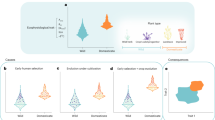Abstract
It has been remarked many times that we really know very little about the ancestors of our cultivated species. I will quote two statements by Harlan (1975):
-
i.
‘In almost no crop do we have a large collection of wild relatives available in anticipation of need’.
-
ii.
‘The study of the origin and evolution of cultivated plants is not only a work of intellectual and academic interest to the evolutionist, but a matter of enormous practical urgency in those crops that carry the burden of supporting the human population’.
Access this chapter
Tax calculation will be finalised at checkout
Purchases are for personal use only
Preview
Unable to display preview. Download preview PDF.
Similar content being viewed by others
References
Gladstones, J.S. 1970. Lupins as crop plants. Field Crop Abstracts 23: 123–148.
Harlan, J.R. 1975. Crops and Man. Madison: American Society of Agronomy.
Harlan, J.R. and de Wet, J.M.J. 1971. Towards a rational classification of cultivated plants. Taxon 20: 509–517.
Zeven, A.C. and van Harten, A.M. 1979. Broadening the Genetic Base of Crops. Wageningen: Centre for Agricultural Publishing and Documentation.
Further reading
Frankel, O.H. and Bennett, E. (eds.) 1970. Genetic Resources in Plants - their Exploration and Conservation. Oxford: Blackwell.
Milner, M. (ed.) 1975. Nutritional Improvement of Food Legumes by Breeding. Washington, D.C. :.John Wiley.
National Academy of Science 1972. Genetic Vulnerability of Major Crops. Washington, D.C.: NAS.
Razdan, M.K. and Cocking, E.C. 1981. Improvement of legumes by exploring extra-specific genetic variation. Euphytica 30: 819–833.
Singh, A.H., Sastri, D.C. and Moss, J.P. 1980. Utilization of wild Arachis species at ICRISAT. Pages 87–93 in Proceedings, International Workshop on Groundnut, ICRISAT, 13–17 October 1980, Patancheru, India: ICRISAT.
Smartt, V. 1980. Evolution and Evolutionary Problems in Food Legumes. Economic Botany 34: 219–235.
Summerfield, R.J. and Bunting, A.H. 1980. (eds.). Advances in Legume Science. Kew: Royal Botanical Gardens.
Ucko, P.J. and Dimbleby, G.W. 1969. The Domestication and Exploitation of Plants and Animals. London: Gerald Duckworth and Co.
Author information
Authors and Affiliations
Editor information
Editors and Affiliations
Rights and permissions
Copyright information
© 1984 Martinus Nijhoff/Dr W. Junk Publishers, The Hague, and ICARDA
About this chapter
Cite this chapter
Cubero, J.I. (1984). Utilization of Wild Relatives and Primitive Forms of Food Legumes. In: Witcombe, J.R., Erskine, W. (eds) Genetic Resources and Their Exploitation — Chickpeas, Faba beans and Lentils. Advances in Agricultural Biotechnology, vol 6. Springer, Dordrecht. https://doi.org/10.1007/978-94-009-6131-9_7
Download citation
DOI: https://doi.org/10.1007/978-94-009-6131-9_7
Publisher Name: Springer, Dordrecht
Print ISBN: 978-94-009-6133-3
Online ISBN: 978-94-009-6131-9
eBook Packages: Springer Book Archive




